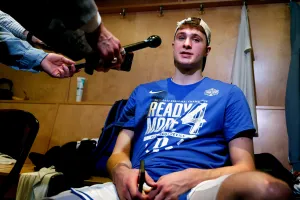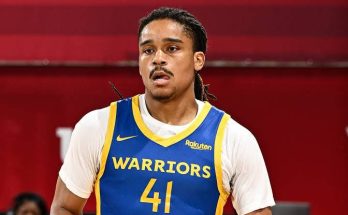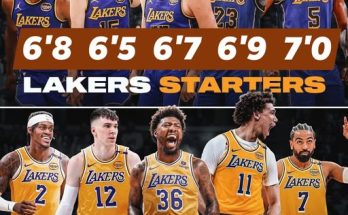“I love New Balance, but Duke is with Nike.” With those simple but telling words, Duke freshman sensation Cooper Flagg offered a rare glimpse into the complex world of college basketball shoe affiliations and athlete preferences. Flagg, the most hyped recruit in recent memory and widely considered a future top pick in the NBA draft, is already a star who commands national attention not only for his play but for everything surrounding his journey on and off the court. That includes his shoes. During the NCAA Tournament, Flagg admitted that he was essentially “forced” to wear Kobe Bryant’s Nike sneakers because Duke is a Nike-sponsored school. The comment might have seemed minor, even playful, but it struck a chord in the ever-growing conversation about athlete individuality, brand influence, and the multimillion-dollar ecosystem of college sports endorsements.
For someone like Flagg, whose personal brand preferences lean toward New Balance, the shoe issue represents more than just comfort or aesthetics. New Balance has slowly carved out its place in basketball after years of being considered a running or lifestyle shoe company, signing stars like Kawhi Leonard, Jamal Murray, and more recently rising prospects who appreciate the performance features and style that the company offers. Flagg, still just at the beginning of his college career, has grown up in a basketball landscape where players his age are more conscious than ever about shoes, sponsorships, and how the gear they wear ties into their identities. When he says he loves New Balance, it’s not just a throwaway statement—it reflects his own vision of what he would prefer to represent if given full choice. But because Duke is locked into a lucrative, long-standing contract with Nike, he has no say in the matter. For now, at least.
The NCAA Tournament is one of the biggest stages in all of sports, and everything about it is carefully controlled, from the logos on jerseys to the warm-ups and shoes that players step onto the hardwood with. Nike, Adidas, and Under Armour have invested billions into securing deals with programs to ensure brand visibility during March Madness. It’s free advertising in the truest sense: every dunk, every highlight, every iconic buzzer-beater becomes a commercial for the shoes the players wear. For Duke, being a Nike school means every player on the roster laces up in swoosh-branded footwear, whether they love Nike or not. For Flagg, this means trading in his beloved New Balance sneakers for the latest pair of Kobe Protro models, shoes that have taken on almost mythical status since Kobe Bryant’s passing and are worn by stars across all levels of basketball.
There’s no denying the appeal of the Kobe line. Many players, from the NBA to college gyms, swear by them because of their lightweight feel, low-cut design, and responsive cushioning that allow for quick cuts and explosive movements. They have become a kind of cultural uniform for serious hoopers, especially in tournament play. Flagg himself acknowledged this when explaining the switch, framing it more as an adjustment he had to accept rather than a choice he made enthusiastically. The underlying tension, however, is that while he is praising Kobe’s shoes for performance, his heart—and perhaps his future endorsements—remain aligned with New Balance.
This moment sheds light on the broader conversation around the agency of college athletes. With the rise of NIL (Name, Image, and Likeness) deals, athletes are finally able to monetize their popularity, sign personal sponsorships, and build brands while still in school. But the shoe companies that sponsor universities complicate this newfound freedom. For example, a player may personally sign an NIL deal with one brand, but if their school is partnered with another, they may be forced to represent the school’s brand during official games. This paradox puts athletes in a bind: on the one hand, they want to stay true to their personal identity and their NIL contracts; on the other, they are contractually obligated to represent the team’s brand when competing.
Flagg’s comment illustrates exactly that dynamic. He is not yet signed to any official shoe company, but his admiration for New Balance is well-documented. When he steps into an NBA arena in the near future, it wouldn’t surprise anyone if he inks a massive deal with the brand, similar to Kawhi Leonard’s high-profile switch from Jordan Brand to New Balance. But until then, he is under the umbrella of Duke’s Nike partnership, which gives him little room for individuality on the court. His statement, half tongue-in-cheek and half serious, reveals the friction between personal choice and institutional contracts in the modern age of college basketball.
What makes this story resonate further is the symbolic weight of the brands themselves. Nike has dominated basketball culture for decades, thanks to its partnerships with Michael Jordan, Kobe Bryant, LeBron James, and countless others. It is the default brand of basketball excellence. New Balance, meanwhile, is the underdog, working hard to shift perceptions from a company once associated with running shoes and dad sneakers to one that produces some of the most technically advanced and stylish basketball sneakers on the market. For Flagg, siding with New Balance sends a message: he is not simply following the crowd. He sees value in the brand that isn’t always in the mainstream spotlight. That individuality might be part of what makes him so compelling as a player and personality.
There is also a performance component to consider. Players at Flagg’s level are incredibly meticulous about their shoes, sometimes even superstitious. They know how a shoe’s cushioning impacts their knees after 40 minutes of play, how the traction holds up on dusty tournament courts, and how the fit affects their ability to move laterally on defense. If Flagg feels most comfortable in New Balance, being forced into a Nike shoe—even one as celebrated as the Kobe line—could feel like a compromise to his game. While the average fan might not notice, for the athlete, this small change can affect rhythm, confidence, and overall performance.
At the same time, his wearing Kobe shoes during the tournament also reflects a broader respect that players have for Kobe Bryant’s legacy. Kobe’s shoes transcend brand loyalty to some degree because they embody a mentality—Mamba Mentality—that resonates universally with basketball players. Even if Flagg loves New Balance, wearing Kobe’s shoes on the biggest stage might have been a source of inspiration and motivation, a symbolic way of channeling the intensity and competitiveness that Kobe represented. In this way, the “forced” element may not have been entirely negative, as Flagg found himself in a product that represents a standard of excellence in the game he is trying to dominate.
The reality, however, is that Flagg’s future will not be defined by what shoes he wore at Duke. In fact, his current experience might make his eventual shoe deal all the more significant. When he declares for the NBA draft, shoe companies will line up with offers, eager to make him the face of their next generation of marketing campaigns. New Balance, given his admiration, would likely push aggressively to sign him, and Flagg’s authenticity in expressing his preference could make him the perfect ambassador for the brand. His story—about being “forced” into Nike during college but finally free to return to his true choice as a pro—would make for a powerful narrative in advertising and branding.
His comment has also sparked discussion among fans, many of whom sympathize with athletes who lose some degree of personal freedom because of school contracts. College sports often emphasize team unity, and having everyone wear the same brand can be seen as part of that cohesion. But in the age of NIL and individuality, the question of whether athletes should be allowed to wear their preferred shoes has gained more relevance. Some argue that forcing a player like Flagg to wear a certain brand undermines the very idea of NIL freedom. Others counter that without the billions funneled into college programs by Nike and other companies, the exposure and financial benefits players receive through NIL might not exist in the first place.
In the end, Cooper Flagg’s candid remark adds another layer to the evolving story of college athletics. It’s a reminder that behind the highlight reels and tournament runs are young athletes navigating the complex intersection of personal preference, corporate contracts, and athletic performance. Flagg’s love for New Balance might clash with Duke’s Nike deal, but it also humanizes him in a way that fans appreciate. He’s not just a prodigy or future NBA star; he’s a teenager who has favorite shoes, favorite brands, and a sense of individuality he’s trying to maintain even under the brightest lights.
As Flagg’s career unfolds, it is almost certain that this early conflict will become a footnote in a much larger story. One day, when he signs his first professional shoe deal, people will look back at these comments as a hint of what was to come. Until then, the sight of him lacing up in Kobe’s Nikes during the NCAA Tournament stands as a testament to the sometimes uneasy relationship between athlete freedom and institutional sponsorship. It’s a small but significant example of how the modern game of basketball is about more than just what happens on the court—it’s about identity, branding, and the ongoing negotiation between personal preference and collective obligations. And if Flagg’s words are any indication, his next chapter will be one where his shoes tell just as much of a story as his jump shots and highlight dunks.



